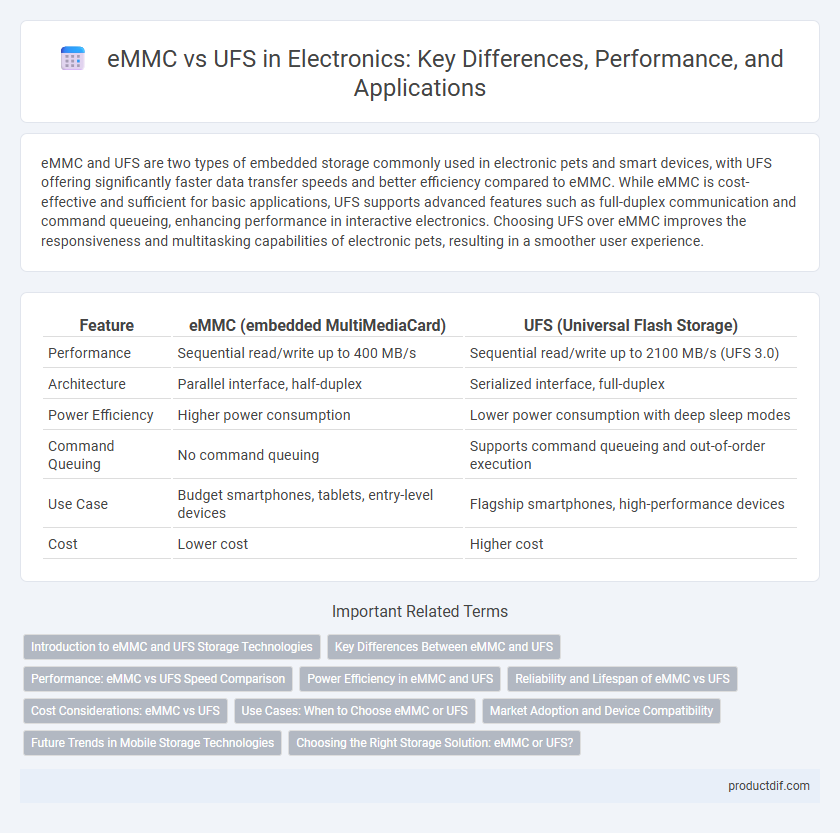eMMC and UFS are two types of embedded storage commonly used in electronic pets and smart devices, with UFS offering significantly faster data transfer speeds and better efficiency compared to eMMC. While eMMC is cost-effective and sufficient for basic applications, UFS supports advanced features such as full-duplex communication and command queueing, enhancing performance in interactive electronics. Choosing UFS over eMMC improves the responsiveness and multitasking capabilities of electronic pets, resulting in a smoother user experience.
Table of Comparison
| Feature | eMMC (embedded MultiMediaCard) | UFS (Universal Flash Storage) |
|---|---|---|
| Performance | Sequential read/write up to 400 MB/s | Sequential read/write up to 2100 MB/s (UFS 3.0) |
| Architecture | Parallel interface, half-duplex | Serialized interface, full-duplex |
| Power Efficiency | Higher power consumption | Lower power consumption with deep sleep modes |
| Command Queuing | No command queuing | Supports command queueing and out-of-order execution |
| Use Case | Budget smartphones, tablets, entry-level devices | Flagship smartphones, high-performance devices |
| Cost | Lower cost | Higher cost |
Introduction to eMMC and UFS Storage Technologies
eMMC (embedded MultiMediaCard) and UFS (Universal Flash Storage) are popular embedded storage technologies used in smartphones, tablets, and other consumer electronics. eMMC offers a cost-effective solution with moderate read/write speeds, typically up to 400 MB/s, suitable for basic applications and mid-range devices. UFS provides significantly faster performance with full-duplex data transfer and speeds exceeding 1,000 MB/s, making it ideal for high-end devices requiring efficient multitasking and advanced multimedia handling.
Key Differences Between eMMC and UFS
eMMC (embedded MultiMediaCard) and UFS (Universal Flash Storage) differ primarily in speed, architecture, and efficiency, with UFS offering significantly faster data transfer rates due to its full-duplex serial interface compared to eMMC's half-duplex parallel interface. UFS supports advanced command queuing and simultaneous read/write capabilities, enhancing performance and power efficiency in mobile and embedded devices. eMMC remains a cost-effective solution for basic storage needs, while UFS is preferred in high-performance applications like smartphones and tablets requiring faster boot and app load times.
Performance: eMMC vs UFS Speed Comparison
UFS (Universal Flash Storage) outperforms eMMC (embedded MultiMediaCard) in speed due to its full-duplex communication and command queuing capabilities, enabling faster read/write operations. UFS Gen 3.0 achieves sequential read speeds up to 2100 MB/s, significantly surpassing eMMC 5.1 speeds capped at around 400 MB/s. The higher input/output operations per second (IOPS) in UFS ensure smoother multitasking and faster app load times compared to the more limited eMMC performance.
Power Efficiency in eMMC and UFS
eMMC and UFS differ significantly in power efficiency, with UFS utilizing a more advanced, low-power architecture that reduces active and idle power consumption. UFS supports command queuing and full-duplex data transfer, enabling faster data throughput with lower energy usage compared to the older eMMC technology. These power-efficient features make UFS the preferred choice for battery-sensitive devices where prolonged battery life is critical.
Reliability and Lifespan of eMMC vs UFS
UFS (Universal Flash Storage) offers superior reliability and longer lifespan compared to eMMC (embedded MultiMediaCard) due to its advanced wear-leveling algorithms and error correction mechanisms. UFS's bidirectional full-duplex interface reduces data corruption risk during simultaneous read and write operations, enhancing overall durability. eMMC's simpler architecture and single-lane design result in faster wear and higher failure rates under intensive use, limiting its lifespan in demanding electronics applications.
Cost Considerations: eMMC vs UFS
eMMC generally offers a lower cost per gigabyte compared to UFS, making it a budget-friendly choice for entry-level and mid-range devices. UFS, while more expensive, provides faster data transfer speeds and improved power efficiency, justifying its higher price in premium smartphones and high-performance electronics. The cost gap between eMMC and UFS continues to narrow as UFS adoption increases and manufacturing processes improve.
Use Cases: When to Choose eMMC or UFS
eMMC is well-suited for cost-sensitive devices requiring moderate performance and storage, such as entry-level smartphones, basic tablets, and IoT gadgets. UFS excels in high-performance applications demanding faster data transfer and multitasking capabilities, including flagship smartphones, advanced tablets, and automotive infotainment systems. Choosing between eMMC and UFS hinges on balancing budget constraints with the need for speed, responsiveness, and power efficiency.
Market Adoption and Device Compatibility
eMMC remains widely adopted in mid-range and budget devices due to its cost-effectiveness and broad compatibility with legacy systems. UFS offers superior performance and energy efficiency, gaining rapid adoption in high-end smartphones, tablets, and automotive applications. Device manufacturers increasingly prioritize UFS for new designs, driven by market demand for faster storage and seamless multitasking capabilities.
Future Trends in Mobile Storage Technologies
Emerging mobile storage technologies are prioritizing speed and efficiency, with UFS (Universal Flash Storage) expected to overtake eMMC (embedded MultiMediaCard) due to its superior sequential read/write speeds and lower latency. Future trends indicate UFS 4.0 and beyond will bring enhancements in power efficiency and higher bandwidth, supporting increasingly demanding applications like 8K video recording and AI processing. Manufacturers are shifting towards UFS to meet consumer demand for faster app load times, smoother multitasking, and enhanced overall device performance.
Choosing the Right Storage Solution: eMMC or UFS?
Choosing the right storage solution between eMMC and UFS depends on device requirements and performance needs. UFS offers significantly faster read/write speeds and better multitasking capabilities, making it ideal for high-end smartphones and tablets. In contrast, eMMC is cost-effective and sufficient for basic devices with moderate storage demands, emphasizing affordability over speed.
eMMC vs UFS Infographic

 productdif.com
productdif.com